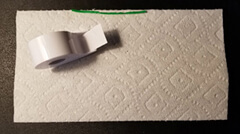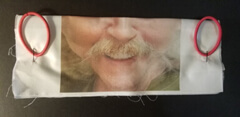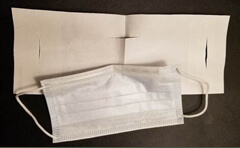 menu
menu
Selfie-mask: instructions
#Smiles2the4
Use our Selfie-mask image generator to allow for a better wrap-around mask effect!
The best thing about all the masks people are wearing is that it saves our lives. The worst thing is that we can't see smiles anymore! The Selfie Mask solves this problem by taking your smile from in back of the mask to the fore! You can help us get this mask idea trending on your favorite social media app by giving us a public mention, using our #Smiles2the4 hashtag.
So let's get started, shall we?…
 Jack sports his selfie-mask
Jack sports his selfie-mask
First, take a selfie as close to your face as possible. If you wear glasses, make sure to remove them. Keep your head as straight and level as you can. Try not to tip the camera because you might end up with an enlarged or distorted nose. Then crop the image such that each cheek is near each edge, the bottom of the chin is near the bottom and the top edge includes the bridge of your nose.
Don't forget the great big cheese-saying smile!
You might have to do a little trial and error, but if you size the image so that it's between 3.8 and 4.2 inches from the bridge of your nose to the tip of your chin you should be in the ballpark.
We have three different methods for creating your Selfie Mask:
 The ideal crop for a selfie-mask
The ideal crop for a selfie-mask
NOTE FOR HEALTH CARE AND OTHER ESSENTIAL WORKERS WHO MUST WEAR CERTIFIED MASKS
We have designed a version of the Selfie-mask which functions as an overlay of most surgical masks. See the end of section 1 for further details. *
1. Printable Fabric
Upload the properly cropped image you created to the Selfie-mask image generator app, then save the stretched image to your device. The Selfie-mask image generator app creates the illusion of the curvature of your face from the flat image you started with.
For this method you need the type of fabric that crafters use to make memory quilts. Do not use fusible fabric or fabric that has adhesive already attached. (If you have tee shirt heat transfer sheets or fusible fabric you can use those on the diagonal bandana below.) Use the kind that has a removable paper backing and that you're supposed to sew or glue yourself. We used the June Tailor, but the Jacquard appears to be similar.
Joann: June Tailor Computer Printer Fabric 10 Pkg
Michaels: Jacquard Inkjet Fabric Sheets
Using whatever application you prefer for printing 8 ½ x 11 pages, insert your cropped and stretched selfie into a file. We used MS Word, rotating once so the chin was to the left, then positioned it flush to the left margin in the center of the page.
 Before & after using the stretching app
Before & after using the stretching app
Set the left margin to as close to 0 as your application or printer will allow. Follow directions on your package of fabric for printing. Don't worry if you mess up the first one, everyone does that.
After the ink is dry and set with a hot iron (or not, depending on your brand of fabric), remove the backing paper carefully. Fold lengthwise across the top of your image.
 Stretched selfie, printed and folded
Stretched selfie, printed and folded
To improve effectiveness, sandwich a half-width paper towel between the two layers of fabric. Tape a twist tie or a short length of pipe cleaner to the top edge of the paper towel to act as a nose piece.


Make sure the rubber bands are attached to the front of the mask as shown.
Pay attention to the washing instructions. We very carefully handwashed ours in warm soapy water and it came out fine.
Also, since we do not sew or have a sewing machine, we've based all these on no-sew methods. If you do sew, you can obviously modify these directions (and greatly improve the project!).


Angela Kostritzky Haws, a seamstress sewing caps and masks for New York City hospitals though the Facebook Group Coast2Coast Makers Collective, noticed the problem of fraying and developed this no-sew method of hemming the masks wrote these, which apply particularly to the overlay method below.
You'll need scissors, fusible tape, elastic string and an iron.
 Items required for no-sew hemming
Items required for no-sew hemming
First, iron your mask flat.

Following instructions on the package, iron on the fusible tape near the edges on the reverse side. Then trim the edges.


Cut small holes on each side for an elastic band. Attach the elastic using method 1 (two knots) or method 2 (a single bow-tie knot).


Snip all four corners, then fold… and iron flat.


Here's the finished product…


NOTE FOR ESSENTIAL WORKERS REQUIRING MANUFACTURED MASKS
Follow these modifications.
Instead of formatting and laying-out as above, use these specifications:
Maximize your printable area while setting up your document or file. My version of Word attached to my HP Officejet printer allows me a to use a printable area with .13" margins on the left and right… but your system may be different.
With that layout, you can fit two masks on a page. After using the Selfie-mask image generator app, lay out the generated image like this, one flush left, one flush right, both centered-aligned. The width doesn't matter much, but if you go over 4 inches high you might not be able to fit two selfie-mask images on a single page.
 Manufactured-type mask
Manufactured-type mask
Follow directions on the fabric package for printing the masks and setting the ink. Then cut along the top of each image, and flip the masks over to reinforce the right and left edges with duct tape.


Next, cut a slit in each piece of duct tape to slip the ear pieces through slits.


And your mask is done.
Now you're ready with a smile AND keeping protocol!


There may be an issue of cleaning or decontamination. And the printed fabric may be difficult to acquire. So alternatively, you can simply follow all the directions above but for printing off on cheap paper.
Reinforce the edges with clear tape. Depending on the kind of paper you have, breathing may be harder, so cut a slit under the nostrils, as pictured below.
When your shift is over, simply discard the mask and use a new one for your next shift.


 Ruby-the-cat lends a paw
Ruby-the-cat lends a paw
2. Diagonally-Folded Bandana
(easy-peasy bandana selfie-mask)
The brilliance of this project is that you can use a full selfie. After this pandemic is all over it'll make a great wall-hanging for your significant other.
Start with a plain white bandana, handkerchief, or a piece of old tee shirt, approximately 20" square. Find the true-center of the fabric. To find the center, we suggest using two strings, like this:

Make a t-shirt transfer using any product you like, carefully following the package instructions. We used Avery Transfers #3275. However, you can also use fusible fabric for this project.
 Avery #3275 fabric-transfer
Avery #3275 fabric-transfer
Set the transfer face down with the bridge of the nose at the center of the bandanna. Iron following package instructions.


Fold it at the bridge of the nose, and… Voila!

Alternative method…
You could also use the Selfie-mask image generator app for this project to maintain the 3-D effect. Print a heat transfer or fusible fabric selfie, cropped according to the directions above EXCEPT position the image, so the bridge of the nose is flush to the left margin (rather than the tip of the chin as above).
Align the left of the sheet, centered, so the bridge of the nose is touching the center point in line with one of the strings.
Apply the image, fold on the diagonal, tie it in the back and you're done!


For our third project we have the double-folded bandana. In this project, your half-selfie is an overlay. It's constructed out of a 20 x 20 bandana and ordinary paper, although you can use white card stock or construction paper as long as it your printer accepts it. One of the good things about this project is that the bandana can be any color or style. You won't need the stretcher app for this.
Start by making a double-folded bandana mask. You can learn how to make the underlying mask here:
JapaneseCreations: No-sew face mask (webpage)
How
to make a pleated, no-sew face mask (YouTube video)
 double-folded cloth mask
double-folded cloth mask
Insert your cropped selfie into a file, centered to the bottom of an 8 ½ x 11 document.

Print on plain paper. Fold along the top of the image so the image is showing.

Cut a couple inches from the top down following the outline of your face. Then cut across from the right and left edges to the cut you made going down.

Unfold the paper and finish cutting out the face. Then cut across the paper to make a tab about an inch high (and 8 ½ inches wide).


Now tuck the tab into the bottom flap of the double-folded bandana.

Depending on the stiffness of the paper you used, you may or may not want to secure the top edge with a bit of clear tape.
Now you're ready to walk around again with that big ol' grin on your face!

Sewn Masks
Unfortunately, we have zero skills when it comes to the sewn cloth masks and no sewing machine even if we did have the skills, but it seems like it should be possible to adapt this idea to sewn masks as well.
But we'll leave this section open for now so that if we get any plans or patterns
that work we have a place to post them.